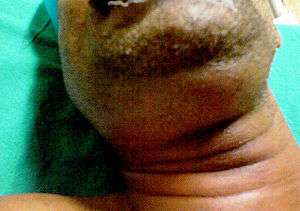Ludwig's angina
| Ludwig's | |
|---|---|
 | |
| Swelling in the submandibular area in a patient with Ludwig's angina. | |
| Classification and external resources | |
| Specialty | gastroenterology |
| ICD-10 | K12.2 |
| ICD-9-CM | 528.3 |
| DiseasesDB | 29336 |
| MedlinePlus | 001047 |
| MeSH | D008158 |
Ludwig's angina, otherwise known as angina ludovici, is a serious, potentially life-threatening cellulitis,[1] or connective tissue infection, of the floor of the mouth, usually occurring in adults with concomitant dental infections and if left untreated, may obstruct the airways, necessitating tracheostomy. It is named after the German physician Wilhelm Friedrich von Ludwig who first described this condition in 1836.[2][3] Other names include "angina Maligna" and "Morbus Strangularis".
Ludwig's angina should not be confused with angina pectoris, which is also otherwise commonly known as "angina". The word "angina" comes from the Greek word ankhon, meaning "strangling", so in this case, Ludwig's angina refers to the feeling of strangling, not the feeling of chest pain, though there may be chest pain in Ludwig's angina if the infection spreads into the retrosternal space.
The life-threatening nature of this condition generally necessitates surgical management with involvement of critical care physicians such as those found in an intensive care unit.[4]
Causes
Dental infections account for approximately 80% of cases of Ludwig's angina.[5] Mixed infections, due to both aerobes and anaerobes, are of the cellulitis associated with Ludwig's angina. Typically, these include alpha-hemolytic streptococci, staphylococci and bacteroides groups.[5]
The route of infection in most cases is from infected lower molars or from pericoronitis, which is an infection of the gums surrounding the partially erupted lower (usually third) molars. Although the widespread involvement seen in Ludwig's usually develops in immunocompromised persons, it can also develop in otherwise healthy individuals. Thus, it is very important to obtain dental consultation for lower-third molars at the first sign of any pain, bleeding from the gums, sensitivity to heat/cold or swelling at the angle of the jaw.
There has been a single case reported where Ludwig's angina was thought to be caused by a recent Tongue piercing.[6][7][8] In addition, Filipino boxer Pancho Villa died after contracting Ludwig's Angina following a bout with Jimmy McLarnin.[9]
Symptoms and signs
Ludwig's angina is a fascial space infection with bilateral involvement of the submandibular, sublingual and submental spaces. The external signs may include bilateral lower facial edema around the mandible and upper neck. Intraoral signs may include a raised floor of mouth due to sublingual space involvement and posterior displacement of the tongue. Symptoms may include dysphagia, odynophagia, difficulty breathing, and pain.
Ludwig's angina should be treated urgently due to the airway being compromised. The infection may rapidly spread to other fascial spaces of the head and neck, further compromising the airway.
Treatment
Treatment involves appropriate antibiotic medications, monitoring and protection of the airway in severe cases, and, where appropriate, urgent Otolaryngology-Head and Neck Surgery, maxillo-facial surgery and/or dental consultation to incise and drain the collections. The antibiotic of choice is from the penicillin group.
Incision and drainage of the abscess may be either intraoral or external. An intraoral incision and drainage procedure is indicated if the infection is localized to the sublingual space. External incision and drainage is performed if infection involves the perimandibular spaces.[5]
A nasotracheal tube is sometimes warranted for ventilation if the tissues of the mouth make insertion of an oral airway difficult or impossible.
In cases where the patency of the airway is compromised, skilled airway management is mandatory. Fiberoptic intubation is common.
Ludwig's angina is a life-threatening condition, and carries a fatality rate of about 5%.[10]
References
- ↑ "Ludwig angina" at Dorland's Medical Dictionary
- ↑ Ludwig's angina at Who Named It?
- ↑ W. F. Von Ludwig. Über eine in neuerer Zeit wiederholt hier vorgekommene Form von Halsentzündung. Medicinisches Correspondenzblatt des Württembergischen ärztlichen Vereins, Stuttgart, 1836, 6: 21-25.
- ↑ Rowe, Ollapallil. "Does surgical decompression in Ludwig's angina decrease hospital length of stay?". ANZ J Surg. Retrieved 2013-01-31.
- 1 2 3 Dhingra, PL; Dhingra, Shruti (2010) [1992]. Nasim, Shabina, ed. Diseases of Ear, Nose and Throat. Dhingra, Deeksha (5 ed.). New Delhi: Elsevier. pp. 277–278. ISBN 978-81-312-2364-2.
- ↑ Body Piercing: To What Depths? An Unusual Case and Review of Associated Problems. Plastic & Reconstructive Surgery. 115(3):50e-54e, March 2005. Williams, Andrew M. M.A., M.R.C.S.(Ed.); Southern, Stephen J. F.R.C.S.(Plast.)
- ↑ Koenig, Laura M.; Carnes, Molly (1999). "Body Piercing: Medical Concerns with Cutting Edge-Fashion". Journal of General Internal Medicine. 14 (6): 379–385. doi:10.1046/j.1525-1497.1999.00357.x. PMC 1496593
 . PMID 10354260.
. PMID 10354260. - ↑ Zadik Yehuda; Becker Tal; Levin Liran (January 2007). "Intra-oral and peri-oral piercing". J Isr Dent Assoc. 24 (1): 29–34, 83. PMID 17615989.
- ↑ http://www.ibhof.com/pages/about/inductees/oldtimer/villa.html
- ↑ Newlands C, Kerawala C (2010). Oral and maxillofacial surgery. Oxford: Oxford University Press. pp. 374–375. ISBN 9780199204830.